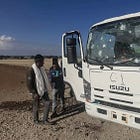Tigray’s plundered gold is being laundered through the UAE
There’s money to be made in Tigray, which produces most of Ethiopia’s gold. But billions of dollars are being lost to an illicit trade run by ex-generals and smugglers bound for the Emirates.
Kaleab Girma and Ashenafi Endale
In Shire, Tigray, just off the town’s main road, there is a bustling market where informal miners sell gold directly to buyers. It gets busiest around 3pm, when both buyers and sellers hear back from their sources elsewhere what gold is going for on world markets. People can pay with cash or cheque. But the best deal is for large buyers: they can take the gold on a delayed payment basis, paying only after smuggling it abroad.
One day in March, when journalists visited the Shire market for this report, a gram was going for 14,000 birr (around $106 at the time) in Shire. This price was 25% higher than the government-set price, and within world market prices which hovered between $100 and $110 in March. Kelali, a former soldier-turned-miner, said the Shire prices were tied to markets elsewhere, particularly Dubai.
This is curious because in Ethiopia – while individuals and entities can be licensed to participate in local gold transactions – the central bank is the only legal exporter of gold.
In the United Arab Emirates, however, travellers do not need to declare carried gold unless its value exceeds 60,000 Emirati dirhams ($16,335). This loophole allows an informal gold trade to thrive. A dealer with a buyer’s licence in Ethiopia can take the yellow metal off Shire sellers on delayed payment terms, smuggle it into the UAE and then sell it for cash in Dubai’s retail gold trade.
A post-war economy
Kelali, who asked to be identified by his first name only, is one of thousands of former combatants of the Tigray Defence Forces (TDF) who, after the region’s brutal 2020-22 war with Ethiopia’s federal government, had no access to structures or resources for a return to civilian life. “The war destroyed Tigray and our old way of life. There was nothing the military leadership could offer us in return for our sacrifice or for our future,” Kelali said.
Tigray produces most of Ethiopia’s gold. In the absence of post-war opportunities, ex-TDF fighters were allowed to form mining cooperatives – typically bands of 25 people – and allocated plots of the region’s gold-rich land. “The war destroyed Tigray and our old way of life. There was nothing the military leadership could offer us in return for our sacrifice or for our future,” Kelali said.
“We mine the gold using traditional manual methods. Then we sell it at local markets,” said Kelali.
Refugees, internally displaced persons and local youth joined in.
According to a 2024 report by local law firm Khermed, there are more than 100,000 artisanal gold miners in Tigray.
Kelali said that Tigrayan generals operate much larger sites. Before the war, the federal government had issued more than 90 mining licences in Tigray.
Two years ago, the Tigray administration asked the mines ministry to revoke 27 of them, including those for gold, saying that the companies had failed to start operations. By this time, Tigrayan generals and their ex-TDF combatants had already taken control of many of the sites.
The generals gave the less-rich lands to low-level soldiers, but kept the larger gold deposits for themselves, said Tedros Kahsay, an ex-TDF combatant. Kahsay now works as head of security for an international NGO which has clearance to enter some of the bigger sites.
Journalists who tried to visit major gold sites in Rahwa, Hitsats, Meli, and Mato Bula for this report were denied permission. The sites are heavily militarised. Guards use reflective signals and warning shots to scare off approachers, restricting outsider access to international NGOs delivering humanitarian aid supplies.
“Our company holds mining licences for the Da Tambuk and Mato Bula sites. However, we have been unable to access them for the past several years. While the federal government is supportive, the regional administration has not cooperated,” said Teketsel Tsige of East Africa Minerals, a Canadian company which hoped for around $70-million in profit from its licences in Tigray.
Teketsel said the sites are currently occupied and operated by illegal miners. “Many of them are former TDF combatants, whom the regional authorities have organised and allowed to mine on our licensed properties. Both artisanal and mechanised illegal mining are taking place.”
That has become the order of the day.
“There are numerous illegal groups currently in control of mining sites across Tigray. These actors operate without any form of licensing, yet they dominate the sites through armed force, particularly targeting gold extraction,” said Fisaha Miresa, a director of the Tigray Mining Bureau. “This situation is widely known. They have heavy machinery, including excavators, and operate the gold mining sites around the clock.”
Multiple sources interviewed for this story said that once legal access to the mining areas was denied, formerly licensed miners pivoted to informal arrangements, collaborating with military generals, ex-combatants and local landowners to maintain a stake.
The extent of illegal mining has surpassed the regional government’s capacity to contain, Miresa said.
Getachew Reda, who was Tigray administrator until April, said last year that the amount of gold smuggled is three to four times what the region legally sells to the central bank.
Tigray sold 12,210kg to the central bank in the first 10 months of 2024/25. Based on Getachew’s estimates – which align with assessments by industry insiders – around 36,600kg of gold, worth $2.5-billion at official central bank export prices, may have been smuggled. Ethiopia’s official gold exports fetched $2-billion in that period. Tigray’s entire annual regional budget is $100-million.
Habibi, come to Dubai
What is happening now in Tigray looks a lot like the gold economy of Sudan, notably in Darfur and Kordafan. Sudanese people took to artisanal gold mining in large numbers in the 2010s during the economic crisis triggered by the breakaway of South Sudan, where most oil reserves were located.
The UAE emerged as a top export destination for this gold, and the Rapid Support Forces paramilitary group came to control Darfur and Kordofan. The civil war, in which the UAE is accused of funding the group, is driven in part by the fight to control those gold flows.
The informality of the UAE’s gold sector allows violent or illicit actors to continue to profit from gold mining. A recent report by SwissAid found that, between 2012 and 2022, 2,569 tonnes of African gold (worth about $115-billion) was imported into the UAE without being declared for export.
Ghana lost up to $11-billion in undeclared gold exports, largely produced by informal miners and exported to the UAE, the report found.
Illegal gold mining has also ravaged mountainsides in Tigray, and miners are polluting rivers with mercury and other metals. They are also causing further displacement.
Tsion is a 37-year-old mother from Hitsats in Asgede Woreda, Tigray who was forced off her ancestral land in March 2024. An excavator appeared at her doorstep one day, accompanied by a group of foreigners escorted by armed TDF members.
“They told me they needed the land for mining. I refused and they imprisoned me,” she said. She was released a week later to find her farmland dug up and destroyed.
Clashes have broken out after local residents resisted attempts to seize land, or when disputes over profit-sharing erupted. In a particularly deadly clash that occurred in August 2024 in Rahwa village, witnesses say that more than 20 people were killed. The violence reportedly erupted after local labourers demanded a greater share of the gold proceeds from their foreign employers.
In Sudan, the civil war that broke out in 2023 – funded in part by the proceeds of the illicit gold trade – has resulted in the world’s worst humanitarian crisis.
And in Ghana, informal mining – called galamsey – has destroyed about 4,726 hectares of land, the BBC has reported.








